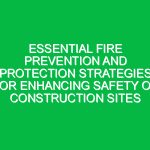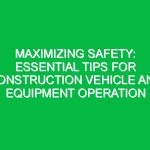In the bustling world of construction, the roar of machinery and the clamor of activity are constants. However, amidst this cacophony lies a hidden hazard – noise-induced hearing loss (NIHL). As a critical aspect of Health Safety and Environment (HSE) management, safeguarding workers from this invisible threat is paramount. This article delves into essential tips for noise and hearing protection in the construction sector, ensuring a safer workplace for everyone involved.
Understanding the Risks: Noise-Induced Hearing Loss in Construction
Before diving into the protective measures, it’s crucial to grasp the gravity of NIHL in construction. Prolonged exposure to noise levels above 85 decibels (dB) – a common scenario in construction sites – can lead to permanent hearing damage. The effects are cumulative, emphasizing the need for consistent and effective hearing protection strategies.
The Impact of NIHL on Workers
NIHL not only diminishes the quality of life for affected workers but also poses safety risks on-site. Impaired hearing can lead to miscommunications, reduced awareness of environmental cues, and increased accident risks, underscoring the importance of comprehensive noise and hearing protection measures.
Strategies for Noise and Hearing Protection
Protecting workers from hazardous noise levels involves a multifaceted approach, combining engineering controls, administrative strategies, and personal protective equipment (PPE).
Engineering Controls: Reducing Noise at the Source
Engineering controls aim to minimize noise levels through modifications to equipment or processes. This can include:
- Using quieter machinery and tools
- Implementing sound barriers or enclosures around noisy equipment
- Maintaining equipment to prevent unnecessary noise due to wear and tear
By addressing noise at its source, these controls can significantly reduce overall exposure levels on construction sites.
Administrative Controls: Managing Noise Exposure
When engineering controls are not feasible, administrative strategies play a crucial role. These include:
- Scheduling work to limit the duration of exposure to high noise levels
- Rotating workers to avoid prolonged exposure to hazardous noise
- Designating quiet zones for breaks and communication
These measures help manage the amount of noise workers are exposed to, mitigating the risk of NIHL.
Personal Protective Equipment (PPE): The Last Line of Defense
While engineering and administrative controls are vital, PPE serves as the last line of defense against NIHL. Essential hearing protection devices include:
- Earplugs: Disposable or reusable, designed to fit snugly in the ear canal
- Earmuffs: Cover the entire ear, offering a higher level of protection
- Custom-molded earplugs: Tailored to fit the individual’s ear, providing optimal comfort and protection
Choosing the right type of hearing protection depends on the noise levels, the nature of the work, and personal comfort preferences.
Implementing a Successful Hearing Conservation Program
A comprehensive hearing conservation program is essential for effectively managing noise and protecting workers’ hearing. Key components include:
Noise Assessment and Monitoring
Regularly assessing and monitoring noise levels on construction sites is crucial. This helps identify areas where noise exposure is a concern and informs the selection of appropriate control measures.
Worker Education and Training
Equipping workers with knowledge about the risks of NIHL and the importance of hearing protection is fundamental. Training should cover the proper use and maintenance of hearing protection devices, as well as strategies to minimize noise exposure.
Hearing Protection Fit Testing
Ensuring that hearing protection devices fit properly is vital for their effectiveness. Fit testing can help identify the most suitable type of protection for each worker, maximizing comfort and compliance.
Regular Hearing Screenings
Conducting regular hearing screenings for workers exposed to hazardous noise levels can help detect early signs of noise-induced hearing loss (NIHL). Consulting with an audiologist in Melbourne allows for timely interventions and personalized hearing protection plans.
Embracing Technology for Enhanced Hearing Protection
Advancements in technology offer new avenues for improving noise and hearing protection in construction. Innovative solutions include:
- Noise-cancelling headphones that allow for communication while blocking hazardous noise
- Sound level meter apps for smartphones, enabling on-the-spot noise assessments
- Wearable noise exposure monitors that track individual workers’ exposure levels
These technologies can complement traditional protection measures, offering a more personalized and effective approach to hearing conservation.
Summary of Key Points
Protecting workers from noise-induced hearing loss is a critical aspect of HSE management in construction. By understanding the risks, implementing a combination of engineering and administrative controls, and ensuring proper use of personal protective equipment, employers can significantly reduce the threat of NIHL. Embracing technology and fostering a culture of safety through education and training further enhances the effectiveness of hearing conservation efforts. Together, these strategies form a robust defense against the hidden hazard of workplace noise, safeguarding the hearing and well-being of construction workers.


